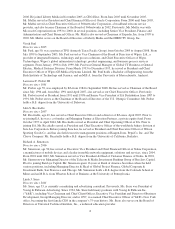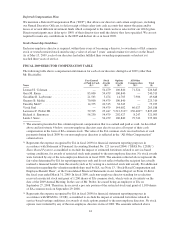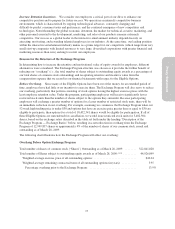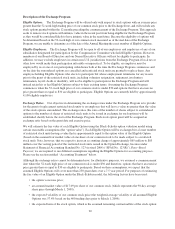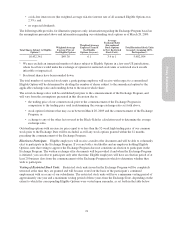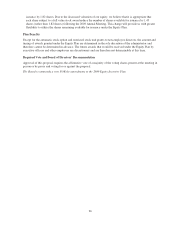Electronic Arts 2009 Annual Report Download - page 25
Download and view the complete annual report
Please find page 25 of the 2009 Electronic Arts annual report below. You can navigate through the pages in the report by either clicking on the pages listed below, or by using the keyword search tool below to find specific information within the annual report.
Proxy Statement
Increase Retention Incentives. We consider our employees a critical part of our drive to enhance our
competitive position and to prepare for future success. We operate in an intensely competitive business
environment, which is characterized by ongoing technological advances, constantly changing and
difficult-to-predict consumer tastes and preferences, and the continual emergence of new competitors and
technologies. Notwithstanding the global economic downturn, the market for technical, creative, marketing, and
other personnel essential to the development, marketing, and sales of our products remains extremely
competitive. Our success as a global leader in the interactive entertainment industry depends heavily on
attracting, motivating, and rewarding talented employees in our industry. At the same time, our leading position
within the interactive entertainment industry makes us a prime target for our competitors (which range from very
small start-up companies with limited resources to very large, diversified corporations with greater financial and
marketing resources than ours) seeking to recruit our employees.
Reasons for the Structure of the Exchange Program
In determining how to increase the retentive and motivational value of equity awards for employees, different
alternatives were considered. The Exchange Program structure was chosen as it provides the further benefit of
reducing our “overhang” (i.e., the total number of shares subject to outstanding equity awards as a percentage of
our total shares of common stock outstanding) and recapturing retentive and incentive value from the
compensation expense that we record in our financial statements with respect to the Eligible Options.
Reduce Overhang. Since many of the Eligible Options have been out of the money for an extended period of
time, employees have had little or no incentive to exercise them. The Exchange Program will also serve to reduce
our overhang, particularly that portion consisting of stock options having the highest exercise prices with the
least employee retention value. Under the program, participating employees will receive significantly fewer
restricted stock units than the number of shares subject to the options they surrender. Because participating
employees will exchange a greater number of options for a lesser number of restricted stock units, there will be
an immediate reduction in our overhang. For example, assuming we commence the Exchange Program when our
52-week high trading price is under $30 and options that have an exercise price greater than or equal to $30 are
eligible to participate, then options for a total of 18,432,341 shares would be eligible for participation. If all of
these Eligible Options are surrendered for cancellation, we would issue restricted stock units for 5,482,504
shares, based on the exchange ratios described in the table set forth under the heading “Description of the
Exchange Program — Exchange Ratios” below, resulting in a net reduction in overhang from the Exchange
Program of 12,949,837 shares or approximately 4% of the number of shares of our common stock issued and
outstanding as of March 28, 2009.
The following chart illustrates how the Exchange Program will affect our overhang:
Overhang Before Option Exchange Program
Total number of shares of common stock (“Shares”) Outstanding as of March 28, 2009: ........ 322,841,828
Total number of Shares subject to outstanding equity awards as of March 28, 2009:(1)(2) ......... 44,926,099
Weighted-average exercise price of all outstanding options: ............................. $42.04
Weighted-average remaining contractual term of all outstanding options (in years): .......... 5.95
Percentage overhang prior to the Exchange Program: ................................ 13.9%
17



